| Pages:
1
2
3
4 |
Ritter
Hazard to Others
  
Posts: 370
Registered: 20-6-2008
Location: Earth
Member Is Offline
Mood: Curious
|
|
| Quote: | Originally posted by Sauron
You made no mention of any proposed collaboration till now; in fact you said you were not writing a book on this. Oh, well, another chance at a
Pulitzer down the crapper, I suppose. |
I believe I mentioned it in one our PMs. I am not writing a book but instead attempting to make sense of the literature on this subject, starting with
the previously missing code for 'diester.' I am in the process of creating ChemDraw files to summarize the chemistry in each of the main patents I
have collected as well as large ChemDraw files summarizing & comparing the synthetic alternatives for each of the principle starting materials in
the V-agent series as well as an overall process flow for VX, which is what I sent you.
As you were quick to send me your email & reinstall your ISIS Draw, I expected this to be a 2-way exchange. Guess not.
Since you and I are apparently the only ones with the technical experience to contribute to this thread, the word collaboration came to mind when it
came to exchanging graphical files. And as far as exchanging graphic files on this chemistry goes, trying to wade through some of the linear
nomenclature you post gets very time consuming. Organic chemistry is a 2-D visual science, not a linear one.
| Quote: | | Here as promised is the JACS paper by Grady Tarbutton. |
Thanks. As I expected it is a hopelessly academic exercise & of little synthetic application.
[Edited on 29-6-2008 by Ritter]
Ritter
=============================
\"The production of too many useful things results in too many useless people.\"
Karl Marx
|
|
|
Sauron
International Hazard
    
Posts: 5351
Registered: 22-12-2006
Location: Barad-Dur, Mordor
Member Is Offline
Mood: metastable
|
|
A hopeless academic exercise perhaps insofar as producing PF3 is concerned, since the main product is POF3.
I think it is not so academic when it comes to POCl3. Since the alternative is via PCl5 and therefore requires elemental P and a lot of Cl2, the
Tarbutton procedure looks pretty attractive.
I understand the frustrations of trying to represent OP structures in Hill notation. I have posted many many .skc files as jpgs on this forum. I just
did not fathom why you reckoned that we needed to take our conversation private.
In the past there have been other members interested in this general topic. I don't know why this thread has been so one-on-one.
Did you download the pages from Saunders I posted?
Sic gorgeamus a los subjectatus nunc.
|
|
|
Ritter
Hazard to Others
  
Posts: 370
Registered: 20-6-2008
Location: Earth
Member Is Offline
Mood: Curious
|
|
| Quote: | Originally posted by Sauron
I understand the frustrations of trying to represent OP structures in Hill notation. I have posted many many .skc files as jpgs on this forum. I just
did not fathom why you reckoned that we needed to take our conversation private. |
You never expressed curiosity about that before. As you can see from the 2 files I sent you, I put quite a bit of effort into the background reseach
before generating them. I have a natural inclination to be protective of my work.
| Quote: | | In the past there have been other members interested in this general topic. I don't know why this thread has been so one-on-one.
|
I have no idea. Looking at the number of views, there is a high level of interest in this topic. But if I'm having difficulty following your Hill
notation posts, then subscribers who aren't graduate chemists may have been discouraged to participate.
| Quote: | | Did you download the pages from Saunders I posted? |
I honestly don't remember. I have the Hoffmann papers. I
have requested a password for the library but have not yet received it.
Ritter
=============================
\"The production of too many useful things results in too many useless people.\"
Karl Marx
|
|
|
Sauron
International Hazard
    
Posts: 5351
Registered: 22-12-2006
Location: Barad-Dur, Mordor
Member Is Offline
Mood: metastable
|
|
Hill notation is common on this forum and I am surprised you have such difficulty with it. Others generally do not, and once again you seem to
underestimate the number of graduate chemists (and Ph.D.'s) here.
for example
MeP(=O)(OEt)SCH2CH2N(Pri)2
which happens to be VX.
a methyl group bonded directly to P
A pi bonded O to P
An ethoxy group to P
and a -S-ethylamino-di-isopropyl side chain bonded to P
Now what is so tough about that?
Patents, journals etc use same notation, so do books, catalogs etc.
It is faster than generating a skc and converting to jpg to post here. I have done that many many times in other threads.
I don't think other members are refraining from posting because of my notation. I think they are refraining because they have little to add. I've been
active here for more than a year and a half, and interest in OP chemistry has not been excessive.
From the start of this thread you have been more interested in the military codes (particularly the ones you lacked) than anything else. Well, from a
purely historical viewpoint I can imagine that is interesting. But those codes convey no chemical information whatsoever. So to chemists they are
meaningless. Chemists do not refer to dichloromethylphosphine as SW. What's that? Tunsten sulfide?
I applaud your ferreting out of the diester code from that inspector's manual. So you were able to complete your graphic, with CAS numbers, ChemDraw
generated IUPAC nomenclature and the Army codes. I am a little vague about why you appeared at first to be ignorant of the thermal isomerization
which is plainly detailed in Eckhaus' patent. Because it is crucial to the process, and that is true whether it takes place in tandem with the
sulfurization step, or, by dint of external chilling, is done seperately. Without understanding the isomerization, one would expect the final product
to be the P=S and O-di isopropylaminoethyl on.
The importance of the isomerization was observed at least as early as the development of Parathion, and again with Systox, and again with Amiton.
These are the pedigree, the ancestry of VX. In each of these commercial insecticides, isomerization resulted in the formation of the the same shift to
-S-ester and O pi bonded to P. This had same profound effect on toxicity, increasing it by "several orders of magnitude" relative to -O-ester and
P=S.
Incidentally there is some confusion in the lit. and on Wiki regarding the structure of Amiton. See the graphical illustrations of these
isomerizations below
[Edited on 30-6-2008 by Sauron]
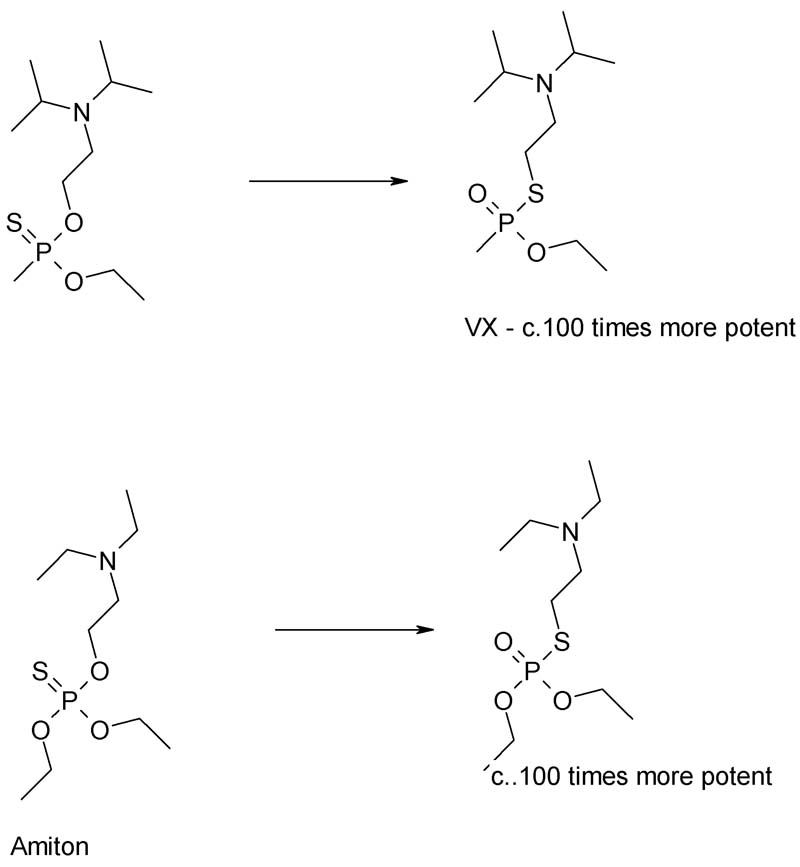
Sic gorgeamus a los subjectatus nunc.
|
|
|
Sauron
International Hazard
    
Posts: 5351
Registered: 22-12-2006
Location: Barad-Dur, Mordor
Member Is Offline
Mood: metastable
|
|
And here's Systox:
[Edited on 30-6-2008 by Sauron]
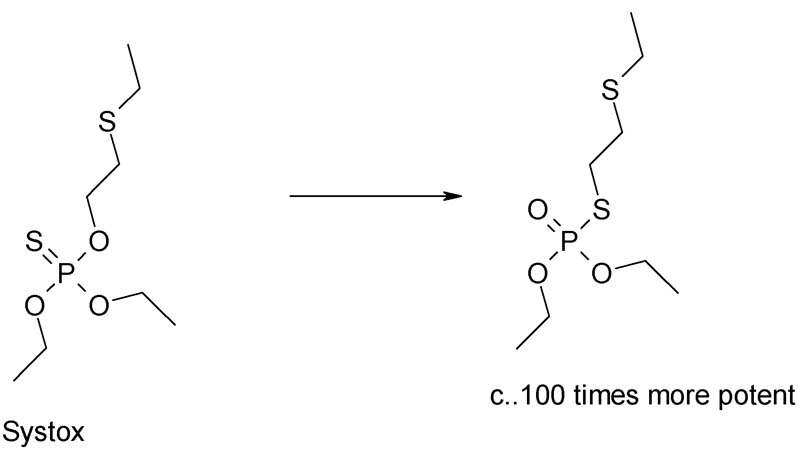
Sic gorgeamus a los subjectatus nunc.
|
|
|
Sauron
International Hazard
    
Posts: 5351
Registered: 22-12-2006
Location: Barad-Dur, Mordor
Member Is Offline
Mood: metastable
|
|
Amiton and Systox were in fact mixtures of both isomers, the isomerization took place partially in the purification process and then gradually at room
temperature, over time. Only later research elaborated this as the cause for anomalous toxocity increases over early tox studies with the pure
O-isomer.
Similar problems arose with parathion which is
(EtO)2P(S)-OPh-4-NO2.
Sources which report the structure of Amiton and/or Systox as
(EtO)2P(=S)SR
where R = -CH2CH2SEt or -CH2CH2NEt2
are in error.
See both Saunders and Hoffmann to support this position.
[Edited on 30-6-2008 by Sauron]
Sic gorgeamus a los subjectatus nunc.
|
|
|
Ritter
Hazard to Others
  
Posts: 370
Registered: 20-6-2008
Location: Earth
Member Is Offline
Mood: Curious
|
|
| Quote: | Originally posted by Sauron
Hill notation is common on this forum and I am surprised you have such difficulty with it. Others generally do not, and once again you seem to
underestimate the number of graduate chemists (and Ph.D.'s) here. |
I have not worked with linear notation very much since college. While I am familiar with it, 2-D graphical representations are the standard format
used today. Understanding a Hill notation listing in the Aldrich catalog is one thing, but trying to follow some of your multi-step OP posts
necessitates my having to visually convert each notation into a 2-D structure so that I can understand what ytou are trying to convey.
| Quote: | Now what is so tough about that?
Patents, journals etc use same notation, so do books, catalogs etc.
It is faster than generating a skc and converting to jpg to post here. I have done that many many times in other threads. |
I think you are just trying to be argumentative. I do not wish to participate on that level. Professional chemists are required to submit 2-D graphics
in their lab notebooks & journal article submissions.
| Quote: | I don't think other members are refraining from posting because of my notation. I think they are refraining because they have little to add. I've been
active here for more than a year and a half, and interest in OP chemistry has not been excessive.
From the start of this thread you have been more interested in the military codes (particularly the ones you lacked) than anything else. Well, from a
purely historical viewpoint I can imagine that is interesting. But those codes convey no chemical information whatsoever. So to chemists they are
meaningless. Chemists do not refer to dichloromethylphosphine as SW. What's that? Tunsten sulfide?
I applaud your ferreting out of the diester code from that inspector's manual. So you were able to complete your graphic, with CAS numbers, ChemDraw
generated IUPAC nomenclature and the Army codes. I am a little vague about why you appeared at first to be ignorant of the thermal isomerization
which is plainly detailed in Eckhaus' patent. Because it is crucial to the process, and that is true whether it takes place in tandem with the
sulfurization step, or, by dint of external chilling, is done seperately. Without understanding the isomerization, one would expect the final product
to be the P=S and O-di isopropylaminoethyl on.
The importance of the isomerization was observed at least as early as the development of Parathion, and again with Systox, and again with Amiton.
These are the pedigree, the ancestry of VX. In each of these commercial insecticides, isomerization resulted in the formation of the the same shift to
-S-ester and O pi bonded to P. This had same profound effect on toxicity, increasing it by "several orders of magnitude" relative to -O-ester and
P=S. |
I have limited experience with OP chemistry, which is one of the reasons I became interested in VX. Are you just trying to make points by being
critical of someone's lack of expertise in a certain area? That's not very nice.
[Edited on 30-6-2008 by Ritter]
Ritter
=============================
\"The production of too many useful things results in too many useless people.\"
Karl Marx
|
|
|
Sauron
International Hazard
    
Posts: 5351
Registered: 22-12-2006
Location: Barad-Dur, Mordor
Member Is Offline
Mood: metastable
|
|
No, just trying to understand some apparent non sequiturs.
I pointed you at free downloads of Saunders book on P and F compounds from forum library, and Kosolapoff's book reviewing OP chemistry from 19th
century through middle of the 20th. I hope you availed yourself of these, which will get you well up to speed at least through the period when VX was
being developed at ICI.
Once you have access to References there is an excellent book in there on the formation of C-P bonds, quite recently published.
I have an excellent review on the Michaelis-Arbusov reaction, would you like to read it?
OP chemistry and phosphorus chemistry in general can get a little strange in places, organophosphorus-sulfur compounds to my mind is one of these
areas, and VX is in there. Organic chemistry is far to vast for anyone to be a generalist any more. We hop from one little island of specialization to
another and hope we don't get our feet wet. Continuing education is nothing to be shy about, or to criticize. We are all of us playing catch-up, all
the time.
[Edited on 30-6-2008 by Sauron]
Attachment: cr00044a004.pdf (2.5MB)
This file has been downloaded 1426 times
Sic gorgeamus a los subjectatus nunc.
|
|
|
Ritter
Hazard to Others
  
Posts: 370
Registered: 20-6-2008
Location: Earth
Member Is Offline
Mood: Curious
|
|
Since I found the information I was looking for at the start of this thread, I now consider this thread closed.
Ritter
=============================
\"The production of too many useful things results in too many useless people.\"
Karl Marx
|
|
|
Sauron
International Hazard
    
Posts: 5351
Registered: 22-12-2006
Location: Barad-Dur, Mordor
Member Is Offline
Mood: metastable
|
|
And I now consider you a pious fraud.
[Edited on 30-6-2008 by Sauron]
Sic gorgeamus a los subjectatus nunc.
|
|
|
Ritter
Hazard to Others
  
Posts: 370
Registered: 20-6-2008
Location: Earth
Member Is Offline
Mood: Curious
|
|
| Quote: | Originally posted by Sauron
And I now consider you a pious fraud.
[Edited on 30-6-2008 by Sauron] |
Why the unnecesary hostility? Didn't I find the code for 'diester' on my own? End of story, end of thread.
Ritter
=============================
\"The production of too many useful things results in too many useless people.\"
Karl Marx
|
|
|
PainKilla
Hazard to Others
  
Posts: 306
Registered: 29-4-2004
Member Is Offline
Mood: No Mood
|
|
I just want to add that I find this thread to be very interesting, at least, where the chemistry was involved. I am quite against the weaponization of
such agents but chemistry is chemistry, and I am sure even these compounds have some medicinal uses (well relatives anyway).
I'd always thought that the chemistry of these agents had been relatively restricted (classified) but it seems that patents, for once, actually have
some validity behind them and are useful for reading (although, some of the notation within is a bit trifling to sort through).
Sauron, out of curiosity, did you pick up your knowledge of these agents through industry experience, or academic coursework, or simply from reading
lots of references? As you mentioned, it is quite difficult to become an expert at organic chemistry, but even so, an introduction to all realms would
be nice, and so I wonder if there is a good place to start (for the chemically inclined)...
Thanks!
|
|
|
Sauron
International Hazard
    
Posts: 5351
Registered: 22-12-2006
Location: Barad-Dur, Mordor
Member Is Offline
Mood: metastable
|
|
Neither industrial experience nor academic work. I was academically trained as a research organiker, including of course being "socialized" to the
literature, C.A., Beilstein etc. Tose are the tools.
Frankly, in hindsight, it is very clear to me that if I had elected to get into pesticides, plant protection chemistry, I would have ended up learning
about never agents anyway because all the "great" nerve agents were accidental offshoots of such research. Simply, insecticides that turned out to be
too potent to use, and then the military sat up and took notice. That was true of Schrader's work at Baeyrt. That was true of Ghost and Newman's work
at Imperial Chemical Industries. Or, getting away from the OPs, it was true of BZ the incapacitant, which grew out of work in the pharm industry to
develop a better smasmolytic. Read the work of Dr.Leo Abood, it's all there. The stuff had unexpected side effects, at first they tried to exploit it
in psychotherapy and found that the drug they thought thay had (Ditran) was rearranging to something else, more potent. They followed that to its
logical conclusion and the quinuclidinal benzilates were born.
And yes all of them, even the nastiest, have had beneficial consequences. I personally consider vesicants like mustard to be crimes against the
genome, because of how they work (by crosslinking DNA and preventing replication and repair). But with that knowledge came the birth of cancer
chemotherapy.
The nerve agents advanced enzymology, and are used in opthamology, treatment of myasthemia gravis etc. (See Saunders.)
Even the early CW agents were just industrial chemicals, or chemicals developed as possible industrial compounds, which turned out to be nasty. This
was true of all the chemical weapons in WWI. All of them. Chemists remembered footnotes in old journals or doctoral dissertations about this nasty
sulfur compound or this stinking arsenical.
I could tell you about one less than lethan agent, now used to incapacitate terrorists. You would not believe the chemistry it came out of. It's a
cannabinoid.
On the other hand when that terrible hostage incident in the CIS happened, they used carfentanyl to do the same thing and managed to kill 30% of the
hostages with it, too. One does not think of the fentanyls as chemical weapons, but there we are.
So what specialization can you go into that will NOT have potential for perversion into a military weapon? That's the tough question.
Sic gorgeamus a los subjectatus nunc.
|
|
|
Sauron
International Hazard
    
Posts: 5351
Registered: 22-12-2006
Location: Barad-Dur, Mordor
Member Is Offline
Mood: metastable
|
|
Ritter, you do not have the authority to close this or any other thread. So don't pretend that you do.
[Edited on 1-7-2008 by Sauron]
Sic gorgeamus a los subjectatus nunc.
|
|
|
Polverone
Now celebrating 21 years of madness
        
Posts: 3186
Registered: 19-5-2002
Location: The Sunny Pacific Northwest
Member Is Offline
Mood: Waiting for spring
|
|
Let's keep this thread on-topic. If you have a problem with another member's behavior, report it to a moderator.
PGP Key and corresponding e-mail address
|
|
|
Formatik
National Hazard
   
Posts: 927
Registered: 25-3-2008
Member Is Offline
Mood: equilibrium
|
|
| Quote: | Originally posted by PainKilla
I just want to add that I find this thread to be very interesting, at least, where the chemistry was involved. I am quite against the weaponization of
such agents but chemistry is chemistry, and I am sure even these compounds have some medicinal uses (well relatives anyway). |
That can be said of at least diisopropyl fluorophosphate, F-P(O)(OC3H7)2, which is quite volatile and has a lethality along the lines of HCN, but its
toxicological action is like the classical nerve gases. Its medicinal use is as a miotic in glaucoma therapy.
|
|
|
Sauron
International Hazard
    
Posts: 5351
Registered: 22-12-2006
Location: Barad-Dur, Mordor
Member Is Offline
Mood: metastable
|
|
DFP was developed by Saunders (q.v.) as a military agent, it is regarded as a first generation OP agent along with octamethylpyrophosphoroamidate
(OMPA), tetraethyl pyrophosphate (TEPP) etc. These paved the way to the second generation tabun, sarin and soman, the G-agents (G for Germany) and
these pointed the way to the V-series (V for venemous) which came along about a decade later. But as I mentioned, this was all serendipity, the
chemists were after pesticides, high mammalian toxicity was undesirable. Still the world situation made militarization unavoidable.
The scary part is that there are at least two maybe three generations of nerve agents that we know very little about. The state parties involved
(Russia and USA) have a conspiracy of silence going, they don't even use consistent euphemisms for these shadowy weapons which are, arguably according
to the Russians, excluded from CWC and other treaties purportedly banning CW.
We can't begin to understand this threat without knowing what came before.
If we leave aside DFP, which is about as toxic as HCN (not very as OP agents go) there are striking similarities between all of the 2nd and 3rd
generation OP agent structures.
The heart of every one of these is a pentavalent phosphorus with a pi bond to oxygen and a sigma bond to an alkoxy group.
Agents of the GA type have a diaminoalkyl group sigma bonded to P and a highly electron withdrawing group such as a nitrile (-CN) also sigma bonded to
P. In the case of GA itself, the substance is N,N-dimenthyl-O-ethylphosphorocyanoamidate (see below).
Other known homologs such as G11, simply replace the methyl groups with n-propyls.
The larger group of G-agents have an alkyl group directly sigma bonded to P, the alkyls being methyl, ethyl, n-propyl or isopropyl. The alkoxy groups
are preferably secondary such as isopropyl or pinacolyl or cyclohexyl. The very characteristic electron withdrawing substituent is fluorine. Examples
are sarin GB, soman GD and cyclosarin GF.
The V-series differ from the above only in that there is no electron withdrawing substituent. Instead there is a highly characteristic -S-CH2CH2NR2
side chain. The most potent known member of the series, VX, is shown upthread. In its instance R = isopropyl, the alkoxy group is ethyl and the alkyl
group is methyl.
The GA agents are in general nonpersistant, meaning that they breakdown to relatively nontoxic products in the environment rather rapidly, the -CN or
-F bonds being labile to hydrolysis. GD is hindered so semipersistant especially in cold climates.
G-agents as a generalization are 10-20 times more toxic than HCN.
V-agents are c10 times more toxic than G-agents, they are quite persistant, difficult to decontaminate, but are not very volatile and primarily
operate as aerosols or by skin absorption.
The 4th/5th and 6th generation agents about which little is known for certain, are believed to be OP agents, of same order of toxicity as VX, and are
designed to defeat MOPP gear, detection systems, and prophylaxis as well as therapeutic agents (antidotes taken before and after exposure
respectively.) The Soviet Union is believed to have developed these weapons starting in late 1950s and continuing ever since, even after the fall of
communism, under cover of various agrochemical research institutes not subject to CWC inspection. What information is in the open literature is
fragmentary, and often unverifiable. For some insight into this see my Novichok thread. This Russian word means Newcomers.
[Edited on 1-7-2008 by Sauron]
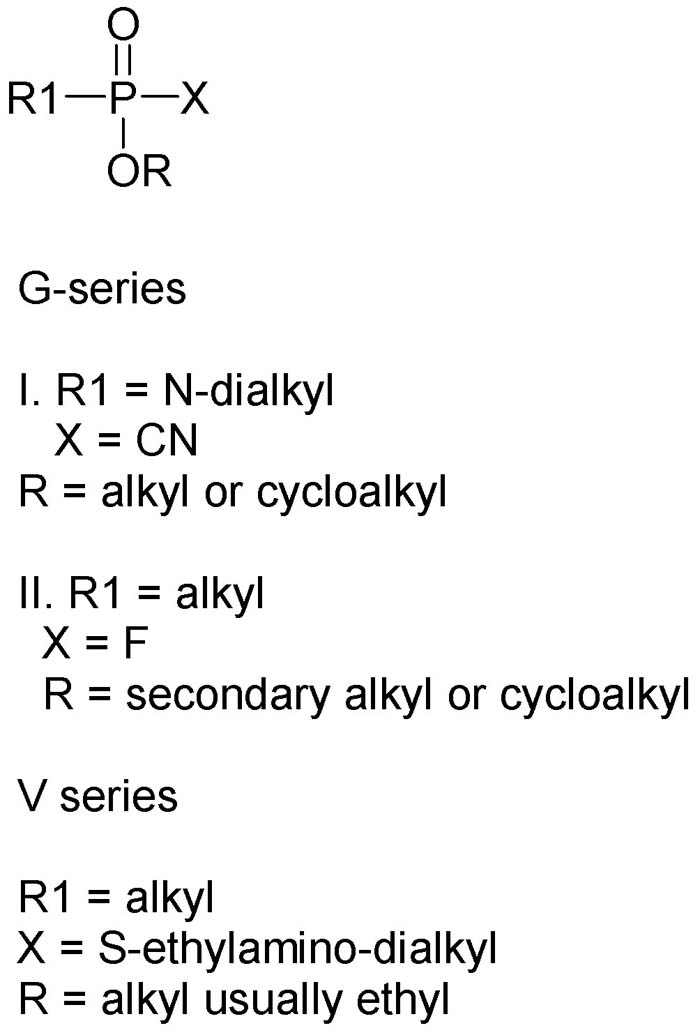
Sic gorgeamus a los subjectatus nunc.
|
|
|
Sauron
International Hazard
    
Posts: 5351
Registered: 22-12-2006
Location: Barad-Dur, Mordor
Member Is Offline
Mood: metastable
|
|
Here are two examples of homologous structures in the G and V series. AFAIK these structures have never been illustrated in the open literature before
now. They were described but not illustrated in the military training manual for CWC inspectors posted by ritter, let's give credit where it is due.
G11 is also referred to as P-GA or propyl-GA.
In addition to PP-VX shown below there is also P1-VX, which is the isopropylphosphine oxide derivative rather than the n-propyl.
[Edited on 2-7-2008 by Sauron]
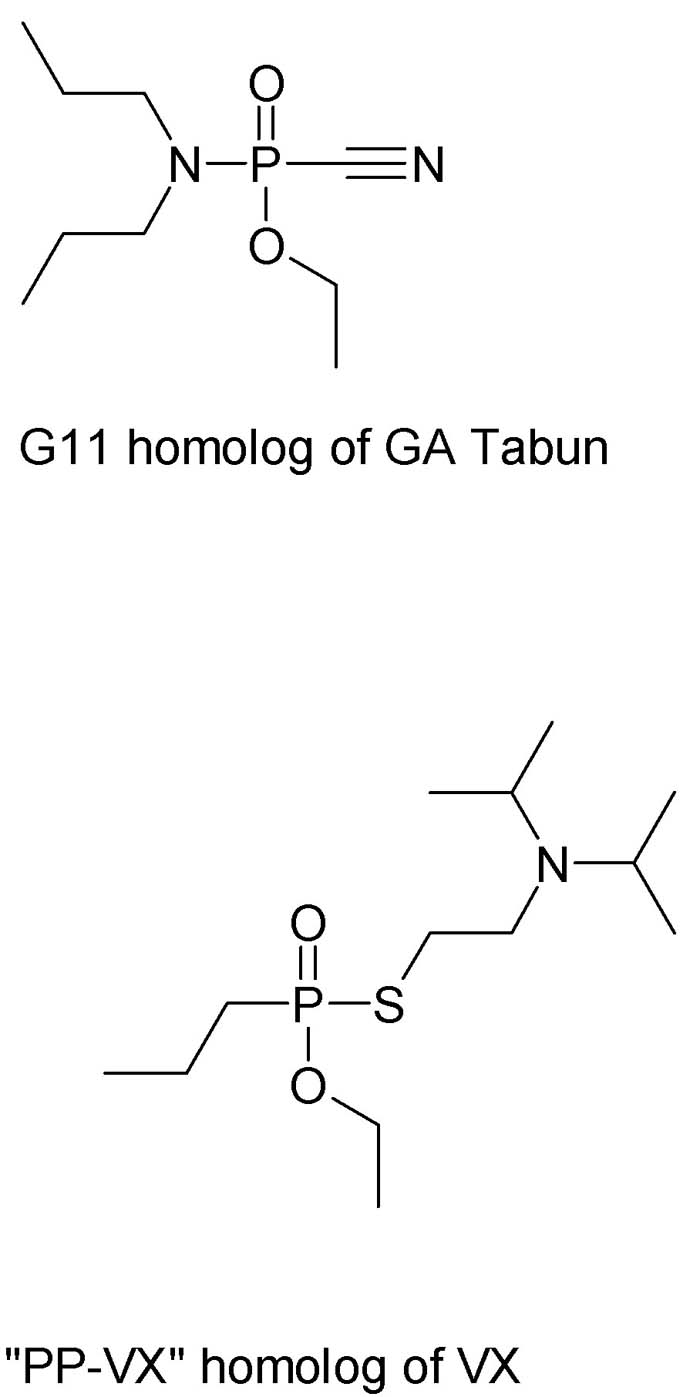
Sic gorgeamus a los subjectatus nunc.
|
|
|
Sauron
International Hazard
    
Posts: 5351
Registered: 22-12-2006
Location: Barad-Dur, Mordor
Member Is Offline
Mood: metastable
|
|
Two more agents in the G series that AFAIK have not been previously illustrated structurally in the open literature.
GE "ethyl sarin" has a CAS number [1189-87-3] so maybe I am wrong.
Again, from US Army manual of CWC scheduled chemicals courtesy of ritter.
There is also an "ethyl GD" (ethyl soman) which is O-pinacolyl ethylfluorophosphine oxide. Also known as E-GD, this agent carries CAS registry no.
[97931-20-9]. The highly hindered ester imparts semipersistance (resistance to hydrolysis in the envirment) to the fluorine moiety. Pinacolyl alcohol
is the product of reduction of pinacolone, the rearrangement product of pinacol. Few who have been classically trained in organic chemistry will
forget having dimerized acetone to pinacol and rearranged it to pinacolone.
[Edited on 2-7-2008 by Sauron]
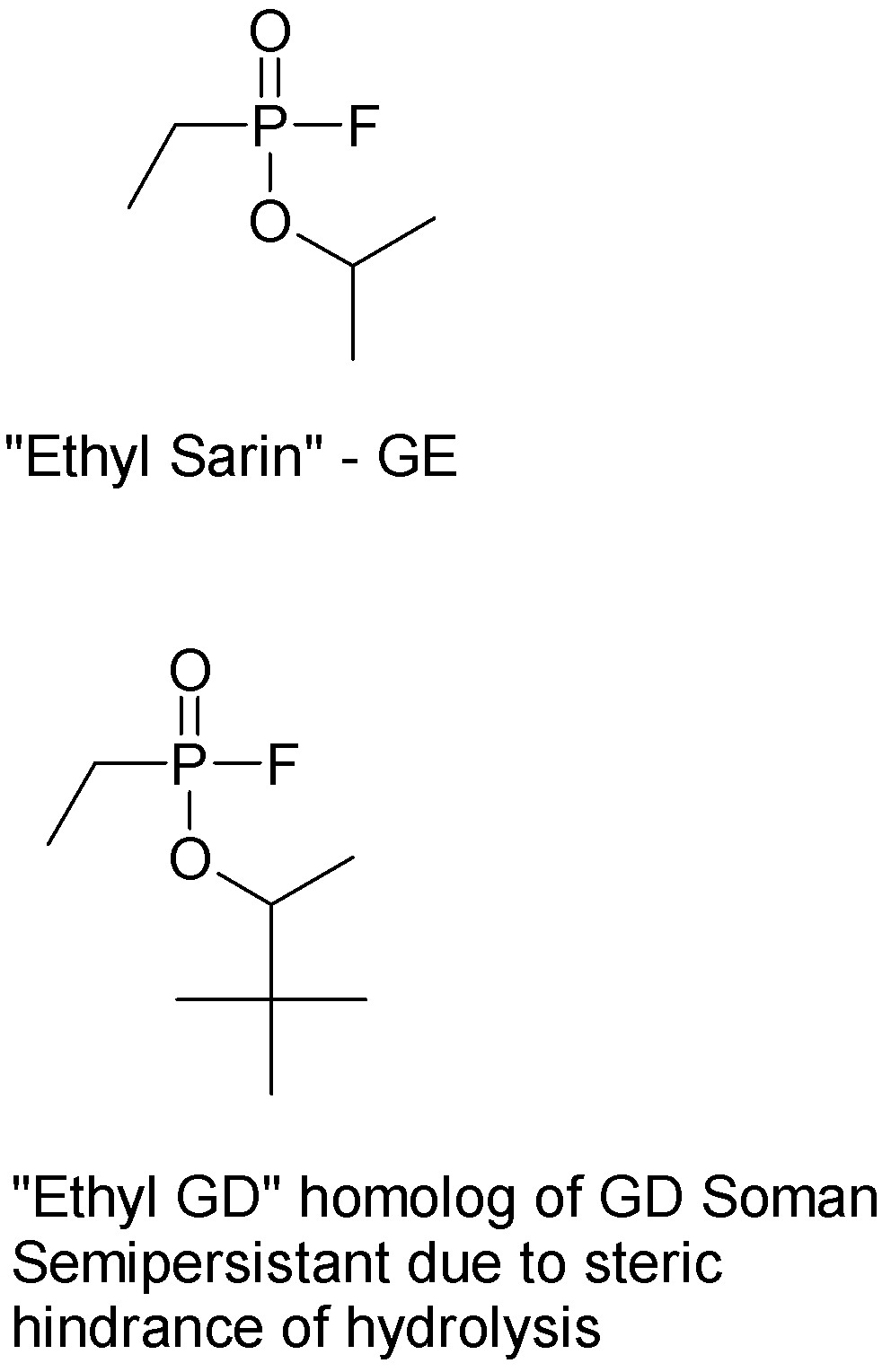
Sic gorgeamus a los subjectatus nunc.
|
|
|
Sauron
International Hazard
    
Posts: 5351
Registered: 22-12-2006
Location: Barad-Dur, Mordor
Member Is Offline
Mood: metastable
|
|
The US Army manual also makes reference to "isopropyl GA" "isopropyl GD" and "isopropyl GF" which in each case are the 2-propylphosphine oxide esters
homologous to the familiar GA tabun, GD soman and GF cyclosarin agents respectively. These are also referred to as I-GA, I-GD and I-GF. Propyl GA
shown earlier is also referred to as P-Ga, not to be confused with the pro golf association! It is reasonable to assume that other alkyl homologs of
G-agents may be similarly identified.
For example PriP(=O)(O-cyclohexyl)F is I-GF
If anyone wants these illustrated explicitly let me know.
[Edited on 2-7-2008 by Sauron]
Sic gorgeamus a los subjectatus nunc.
|
|
|
Sauron
International Hazard
    
Posts: 5351
Registered: 22-12-2006
Location: Barad-Dur, Mordor
Member Is Offline
Mood: metastable
|
|
It has come to my attention that my claim upthread to be the first to illustrate the structures of a number of the G and V series agents and their
homologs is partially incorrect.
Compendium of Chemical Warfare Agents by S.Hoening does show some (but far from all) of these, particularly the agents with G and V codes.
Structure graphics for the following, however, do appear to be novel in the open literature:
E-GA, E-GD, E-GF ethyl homologs of alkyl groups in G series
P-GA, P-GB, P-GD, P-GF n-propyl homologs
I-GA, I-GB, I-GD, I-GF 2-propyl homologs
G-11 or G11 N,N-di-n-propyl homolog of GA
PP-VX n-propyl homolog of alkyl group on phosphorus in VX
No CAS Registry numbers were published for these structures. All are within the regulated envelope of CWC. Certain other homologs are obviously
implied particularly in the V-series. I have omitted their structural drawings for lack of their mention in any open source document (at least to my
knowledge) thus far.
Sic gorgeamus a los subjectatus nunc.
|
|
|
| Pages:
1
2
3
4 |